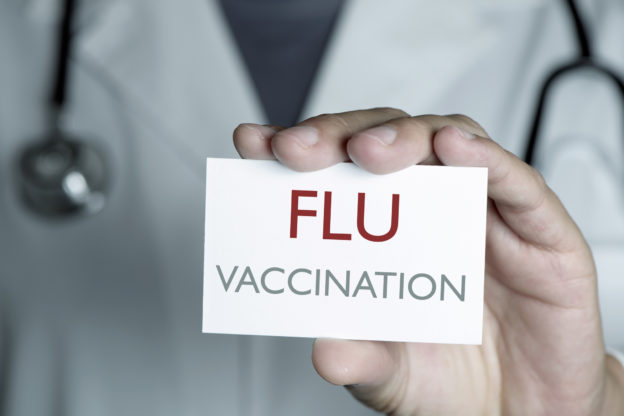The seasons are changing – warm summer days at the pool will turn into cool fall days. As a pediatrician, I can tell the seasons have changed as my appointments go from nearly all school physicals to sick visits. This also means flu season is almost here.
The flu, or influenza, is “the Hulk” version of a cold – it is longer lasting and more intense than your typical illness. If you get the flu, you can expect to be sick with fevers, body aches, coughing, runny nose or congestion, a stomach ache and possible vomiting. These symptoms with typical colds last for 7-10 days. With the flu, you tend to have more intense symptoms for longer – 14 days is more typical.
Influenza does not discriminate – it infects the young, middle aged and old, male and female, those who eat healthy and those who don’t. It is spread by respiratory secretions: sneezing, boogers and coughing basically! It tends to cause the worst illness in the very young (newborns, infants, toddlers) and the elderly.
While for most, the flu will be a miserable few weeks of illness, those who are less lucky may have complications. These complications can require hospitalization and range from ear infections, pneumonia, meningitis, and most terribly, death. Last season, hundreds of thousands of people were hospitalized and deaths reached record numbers: nearly 200 children were among those who died after contracting the flu.
I’ve painted a pretty bleak picture, I know. So what can you do about this for you and your family? While I can’t offer much to prevent the common cold that will start to frequent our communities soon (other than hand washing and staying away from sick people), influenza is something I can offer some protection from: with the flu shot! Everyone with a working immune system (i.e. not fighting cancer for example) from ages 6 months and upward can and should get a flu shot yearly.
I know, I know…no one likes shots. And the flu shot gets a really bad reputation – I hear all sorts of reasons people don’t want to get the flu shot. People tell me it made them sick, it didn’t work, they are afraid of the side effects of the shot, or they haven’t gotten sick after skipping the shot in the past so don’t see the need for the shot of prevention. So let’s talk about the vaccine a little bit…
The flu shot is a killed vaccine – it cannot give you the illness. Most viruses, though, hide in our body for 3-5 days before producing any symptoms. So many people who get sick after getting the flu shot were already harboring their illness before they got their shot. In other words, it wasn’t the shot that got them sick.
Vaccines don’t work immediately either – to build full protection from the flu vaccine, you need to give your body 2 weeks to respond – this is why we recommend vaccination by November at the latest to protect yourself well before flu is heavily circulating. In kids 8 years old and younger, the first year getting the vaccine will require 2 shots separated by 1 month. Every year after that is only one booster.
Now I’m going to be honest with you: the flu shot isn’t perfect. There are multiple strains that circulate and the virus is smart and can morph mid-season. These facts make it hard to make a perfect vaccine. It also means the vaccine is only moderately good at fully preventing the flu.
Even so, if you come down with the flu after receiving your flu shot, your illness should be milder since your body has some awareness of the virus already.
Additionally, while full prevention may only be modest, prevention of severe illness and complications is excellent in those who receive the flu shot. In those who died of flu, more than 80% were NOT vaccinated. That’s a powerful statistic.
Beyond this, comparing risks versus benefits of getting the flu over getting the flu shot, the benefits of the vaccine WAY outweigh the risks. Risks of the flu shot may include allergic reaction (which is so rare that even people with allergies to components of the shot are recommended to still get the vaccine), redness, welt, soreness at the site. Other more scary reactions are so rare that they are hard to even quantify. On the other hand, risks of influenza are easily measured (remember all the complications I mentioned above), and occur to thousands of people across the globe annually.
Here’s the thing. You probably won’t get the flu every year – some estimates are that people contract the flu every 5-10 years. So sure, you could try to get lucky and not get your flu shot. But, you getting your flu shot not only gives you a chance at prevention, it also helps stop the spread of flu in the community. You getting your shot helps keep the newborn next door, your grandma, your friend with cancer and the rest of your family from getting the flu too. The more people that get protection, the less the flu will take hold of our community.
On a final note, I choose to have my family vaccinated every year from the flu. This is my choice. I would never recommend anything to my patients that I wouldn’t do for my family. We all got our family flu shots this year together! I’m pregnant as well which means my baby will have some protection via the womb after birth. Yes – pregnant women should also get the flu shot to protect themselves and their growing babies.
So here’s the message: get your flu shot and get it now. For yourself, your family, your pregnant friend, those with compromised immune systems (everybody knows someone with cancer, right?), the newborns and the elderly. Encourage others to get protected as well. Not only will the vaccine help you stay well, it will help keep others well too! As always, if you have questions, talk to your doctor about your specific health situation.






